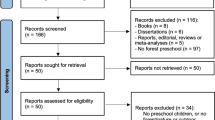Abstract
Early childhood educators are greatly concerned about the value of classroom materials for young children's development. Blocks continue to be favored by many as a way of facilitating the developmental domains in children. In fact, blocks are considered the most useful and most used equipment in preschool and kindergarten programs. (Benish, 1978; Kinsmans & Berk, 1979). Variations in shapes, sizes, and weight foster learning experiences from infancy through early childhood.
Similar content being viewed by others
References
Beeson, B. S., & Williams, R. A. (1979).A study of sex stereotyping in child-selected play activities of pre-school children. Munice, IN: Ball State University. (ERIC Document Reproduction Service No. ED 186 201.)
Benish, J. (1978).Blocks: Essential equipment for young children. Charleston, WV: West Virginia State Department of Education. (ERIC Document Reproduction Service No. ED 165 901.)
Cartwright, S. (1988). Play can be the building blocks of learning.Young Children, 43 44–47.
Hirsch, E. S. (1984). Block building: Practical considerations for the classroom teacher. In E. S. Hirsch (Ed.),The block book (pp. 89–102). Washington, DC: National Association for the Education of Young Children.
Johnson, H. M. (1966).The art of block building. New York: Bank Street College of Education Publications.
Kinsman, C., A., & Berk, J. (1979). Joining the block and housekeeping areas. Changes in play and social behavior.Young Children, 35 66–75.
Rogers D. L. (1985). Relationships between block play and the social development of young children.Early Child Development and Care, 20 245–261.
Varma, M. (1980).Sex-stereotyping in block play of preschool children. New Brunswick, NJ: Rutgers University. (ERIC Document Reproduction Service No. ED 197 832.)
Additional information
Janis R. Bullock is Assistant Professor of Early Childhood Education, Department of Health and Human Development, Montana State University, Bozeman, MT.
Rights and permissions
About this article
Cite this article
Bullock, J.R. Learning through block play. Early Childhood Educ J 19, 16–18 (1992). https://doi.org/10.1007/BF01617077
Issue Date:
DOI: https://doi.org/10.1007/BF01617077




